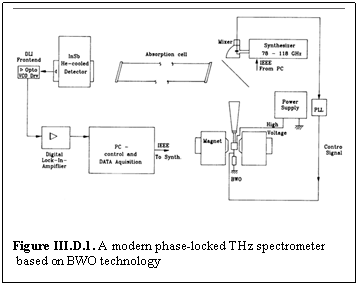
D. Electron Beam Sources: Although the emphasis for the last several decades has been on solid state source development, electron beam devices have played an important role in THz spectroscopy. In fact, as can be seen in Table III.D-1, Backward Wave Oscillators (BWOs) significantly exceed the broadband power producing capabilities of solid state sources shown in Fig. III-1. Although beyond the scope of this article, it is probably worth noting that there is virtually no limit (other than economic) on the amount of power that can be produced in the THz region by e-beam sources. For example, a new Free Electron Lasers (FEL) designed at UCSB to be driven by a 2 MeV electron beam would produce 1 kW cw at 300 GHz. As shown by Madey, FELs are formally equivalent to classical tubes. Arbitrarily high power at high frequency can be obtaining by raising the energy of the electron beam, especially into the relativistic regime where the 'size' limitations on THz sources are transcended by relativistic effects. While the limits on electron energy in solid state sources preclude such an approach, it is likely that a functionally equivalent solution will ultimately be obtained by the integration of large arrays of individually small solid state sources.
Table III.D-1. ISTOK BWO characteristics. |
For the region between about 100 and 1000 GHz, Backward Wave Oscillators (BWOs)1 have been extremely useful sources. The most successful commercial devices have been produced by ISTOK (Russia)2 and Thompson-CSF (France), although the latter ceased production several years ago due to economic/market considerations. The former have attracted a wide following and are particularly attractive spectroscopic sources, offering wide voltage tunability and milliwatt power levels. Table III.D-1 shows typical characteristics. A comprehensive review of Soviet era systems has been written3 and a number of more recent articles have 4, 5

Figure III.D-1 shows a modern implementation of the basic spectroscopic scheme.5 In this system the frequency reference is provided by a step tunable millimeter wave synthesizer whose output is harmonic mixed with a portion of the BWO signal in a quasi-optical harmonic mixer. This reference is then used to phase-lock the BWO, which in turn tracks the frequency scan of the synthesizer. Figure III.D-2 shows a comparison of the Doppler limited with this system and that from a large, high resolution FTIR system. Although under equilibrium conditions line- widths around 1 THz are ordinarily Doppler limited to ~ 1 MHz, the spectral purity and power of BWO sources make possible the use of saturation spectroscopy to significantly reduce this limit. In a particularly interesting demonstration Belov and his coworkers have observed ~ 0.05 MHz wide saturation features in the ammonia spectrum near 570 GHz.6 Both the and line-width of the system are
dramatically illustrated in Fig.III.D-3 which shows spectra for both 14NH3 and 15NH3 in natural a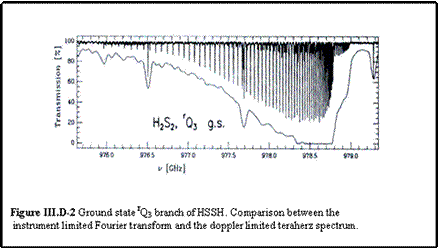 bundance (0.366%). Finally, we will discuss in somewhat more detail a relatively new approach to THz spectroscopy, the Fast Scan Submillimeter Spectroscopy Technique (FASSST).7 Like the spectral region itself, it adopts methodologies from both the neighboring microwave and infrared regions. In Section V we will discuss a particular application, analytical chemistry.8
bundance (0.366%). Finally, we will discuss in somewhat more detail a relatively new approach to THz spectroscopy, the Fast Scan Submillimeter Spectroscopy Technique (FASSST).7 Like the spectral region itself, it adopts methodologies from both the neighboring microwave and infrared regions. In Section V we will discuss a particular application, analytical chemistry.8
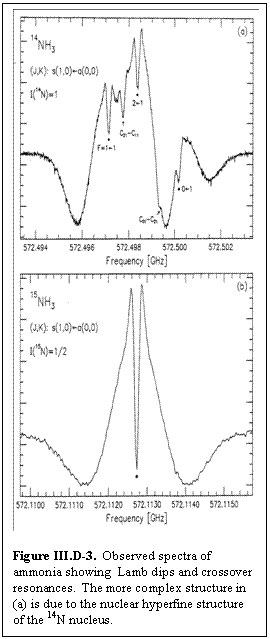
Figure III.D-4 shows the FASSST system that was used to produce the series of spectral expansions shown in Fig.II-1. In this example, an ISTOK OB-30 BWO is used to cover the 240 - 375 GHz region. Similar tubes are available from ISTOK for the ~100 - 1000 GHz region. The first wire grid polarizer(WG1) provides a well defined polarization from the output of the over-moded BWO waveguide. The second polarizer (WG2) is used to split the output power of the BWO, with ~90% being directed quasi-optically through themolecular absorption cell and detected by an InSb hot electron bolometer operating at 1.5 K. The remaining ~10% of the power is coupled into a Fabry-Perot (FP) cavity via a Mylar beam-splitter (BS1), which provides fringes for frequency interpolation between reference spectral lines of known frequency. In order to provide a highly accurate basis for the analysis of the fre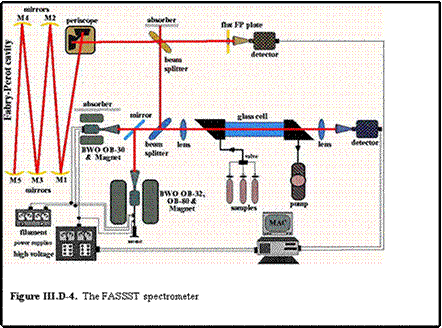 quency-voltage characteristic of the BWO, a folded FP cavity of length ~38.89 m is used to provide modes every ~3.854 MHz. A second molecular absorption cell that can be used for calibration purposes is also provided.
quency-voltage characteristic of the BWO, a folded FP cavity of length ~38.89 m is used to provide modes every ~3.854 MHz. A second molecular absorption cell that can be used for calibration purposes is also provided.
The philosophy behind this system is based on the fact that, like most e-beam based microwave oscillators, the source line-width (short-term stability) of the BWO oscillator is much less than the Doppler width of a spectral line. Thus, the phase-lock approach discussed above is needed not to improve this spectral purity, but rather to stabilize against thermal and power supply induced long term (≥ 0.01 sec) drift and ripple. It is straightforward to show that a combination of power supply development and a fast frequency scan can ‘freeze’ these instabilities, so long as a frequency reference can be provided which will allow the BWO’s frequency instability to be calibrated in software.7 The size of the FP cavity is dictated by the need to interpolate between adjacent FP cavity modes and the details of the small scale structure of the frequency-voltage characteristic of the BWO. Figure III.D–5 shows a typical example. 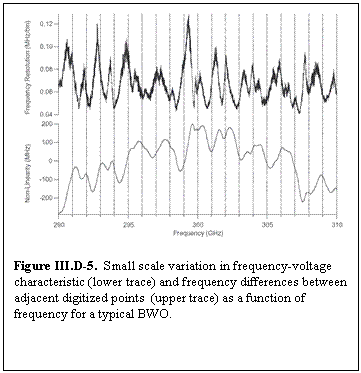 These fluctuations are caused by standing wave phenomena both within and external to the tube. The key system elements include:
These fluctuations are caused by standing wave phenomena both within and external to the tube. The key system elements include:
(1) The most fundamental element of the FASSST system is the excellent short term spectral purity of the BWO. From studies over many years, it has been observed that the short-term spectral purity of free running ISTOK BWOs is <20 kHz. Without this spectral purity, the FASSST system would not be possible.
(2) Secondly, the BWOs can be voltage tuned continuously over an ~50% frequency range, which
(3) The synthesized frequency reference system typical of high resolution
submillimeter spectrometers is replaced by a system more typical of optical spectroscopy. However, the longer wavelength significantly relaxes the requirements for optical precision and much greater frequency accuracy can be achieved.
(4) A fast (~105 spectral resolution elements/sec, currently limited by detector bandwidth) sweep and data acquisition system 'freeze' any drift in the source frequency over the time required to sweep from one reference fringe to the next. This eliminates the need for active frequency stabilization.
(5) Fast data acquisition and calibration hardware and software. In a very general sense, the bandwidth of this system plays the same role as the bandwidth of the lock loops of more traditional systems.
The combination of these five elements make it possible to measure thousands of spectral lines per second, with a frequency accuracy of a small fraction of a Doppler width (<0.1 MHz/3 x 10-6 cm-1). Signal averaging is straightforward, and for equivalent integration times the sensitivity is the same as for slow-sweep, synthesized phase locked systems. Finally, the system is very simple in both concept and execution and holds the promise of being used in a wide variety of applications.
References
[1] R. Kompfner and N. T. Williams, "Backward-Wave Tubes," Proc. IRE, vol. 41, pp. 1602-1611, 1953.
[2] M. B. Golant, Z. T. Alekseenko, Z. S. Korotkova, L. A. Lunkina, A. A. Negirev, O. P. Petrova, T. B. Rebrova, and V. S. Savel'ev, "Wide-Range Oscillators for the Submillimeter Wavelengths," Pribory i Tekhnika Éksperimenta, vol. 3, pp. 231-237, 1969.
[3] A. F. Krupnov and A. V. Burenin, "New Methods in Submillimeter Microwave Spectroscopy," in Molecular Spectroscopy: Modern Research, vol. II, K. N. Rao, Ed. New York: Academic Press, 1976, pp. 93-126.
[4] G. Winnewisser, A. F. Krupnov, M. Y. Tretyakov, M. Liedtke, F. Lewen, A. H. Saleck, R. Schieder, A. P. Shkaev, and S. V. Volokhov, "Precision Broadband Spectroscopy in the Terahertz Region," J. Mol. Spectrosc., vol. 165, pp. 294-300, 1994.
[5] G. Winnewisser, "Spectroscopy in the terahertz region," Vib. Spectrosc., vol. 8, pp. 241-253, 1995.
[6] S. P. Belov, T. Klaus, G. M. Plummer, R. Schieder, and G. Winnewisser, "Sub-Doppler Spectroscopy of Ammonia Near 570 GHz," Z. Naturforsch, vol. 50a, pp. 1187-1190, 1995.
[7] D. T. Petkie, T. M. Goyette, R. P. A. Bettens, S. P. Belov, S. Albert, P. Helminger, and F. C. De Lucia, " A Fast Scan Submillimeter Spectroscopic Technique," Rev. Scient. Instrum, vol. 68, pp. 1675-1683, 1997.
[8] S. Albert, D. T. Petkie, R. P. A. Bettens, S. P. Belov, and F. C. De Lucia, "FASSST: A new Gas-Phase Analytical Tool," Anal. Chem., vol. 70, pp. 719A-727A, 1998.